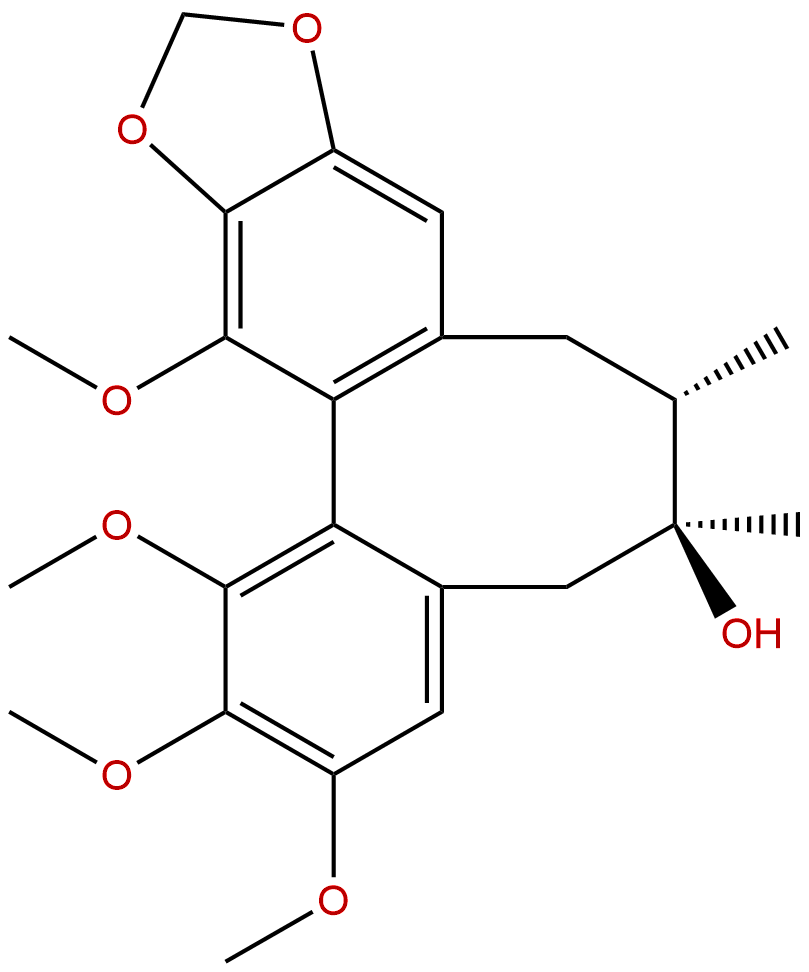
Schizandrol BCAS No.:58546-54-6
|
||||||||||
 |
|
|
||||||||

| Catalogue No.: | BP1266 |
| Formula: | C23H28O7 |
| Mol Weight: | 416.47 |
Product name: Schizandrol B
Synonym name: schisandrol B; Wuweizi alcohol B; Besigomsin; Wuweizi alcohol B; Gomisin A
Catalogue No.: BP1266
Cas No.: 58546-54-6
Formula: C23H28O7
Mol Weight: 416.47
Botanical Source: Schisandra chinensis(Turcz.)Baill.
Physical Description:
Type of Compound: Lignans
Purity: 95%~99%
Analysis Method: HPLC-DAD or/and HPLC-ELSD
Identification Method: Mass, NMR
Packing: Brown vial or HDPE plastic bottle
Storage: Store in a well closed container, protected from air and light. Put into refrigerate or freeze for long term storage.
Whenever possible, you should prepare and use solutions on the same day. However, if you need to make up stock solutions in advance, we recommend that you store the solution as aliquots in tightly sealed vials at -20℃. Generally, these will be useable for up to two weeks.
The product could be supplied from milligrams to grams
Inquire for bulk scale.
Description:
Gomisin A has anti-inflammatory, antihypertensive, neuroprotective, and anti-proliferation properties, it induces marked protective effects against hepatic and renal injury induced by CCl(4) exposure through differential regulation of the MAPK signal transduction pathway. Gomisin A inhibits COX-2, iNOS, IL-6, TNF-α and NO through the down-regulation of RIP2 and NF-κB activation.
References:
Int J Mol Med. 2013 Apr;31(4):888-98.
Protective effects of gomisin A isolated from Schisandra chinensis against CCl(4)-induced hepatic and renal injury.
The aim of the present study was to investigate the protective effects of Gomisin A, a lignan compound isolated from Schisandra chinensis, against liver and kidney damage induced by CCl(4) exposure.
METHODS AND RESULTS:
We assessed alterations in organ weights, levels of serum biochemical indicators, and activation of the caspase-3 and MAPK signaling pathways and carried out histological analysis of liver and kidney tissue in rats pretreated with Gomisin A for four days. In the Gomisin A/CCl(4)-treated group, only the liver experienced a significant increase in weight, whereas the other organs did not undergo any changes. Five biochemical indicators in serum indicated that liver and kidney toxicity dramatically decreased upon Gomisin A pretreatment, although the decrease in ratios varied. Upon histological analysis, the Gomisin A/CCl(4)-treated group showed less hepatocellular necrosis, a poorly dilated central vein in the liver section, decreased diameter of the glomerulus, a lower number of capillaries, and a convoluted tubule in the kidney section. Furthermore, the formation of active caspase-3 was inhibited by Gomisin A pretreatment in the Gomisin A/CCl(4)-treated group, whereas the expression level of Bax protein was slightly increased. Western blot analysis revealed that there were differences between the liver and kidney in terms of activation of the MAPK signaling pathway. In the liver, Gomisin A pretreatment increased phosphorylation of three members of the MAPK pathway when compared to that in the vehicle pretreatment group. However, in the kidney, only the phosphorylation level of p38 was elevated upon Gomisin A pretreatment, whereas levels of the other two members were decreased.
CONCLUSIONS:
These results suggest that Gomisin A induces marked protective effects against hepatic and renal injury induced by CCl(4) exposure through differential regulation of the MAPK signal transduction pathway.
Biol Pharm Bull. 2012;35(11):1997-2003.
Gomisin A enhances tumor necrosis factor-α-induced G1 cell cycle arrest via signal transducer and activator of transcription 1-mediated phosphorylation of retinoblastoma protein.
Gomisin A, a dibenzocyclooctadiene lignan isolated from the fruit of Schisandra chinensis, has been reported as an anti-cancer substance. In this study, we investigated the effects of Gomisin Aon cancer cell proliferation and cell cycle arrest in HeLa cells.
METHODS AND RESULTS:
Gomisin A significantly inhibited cell proliferation in a dose-dependent manner after 72 h treatment, especially in the presence of tumor necrosis factor-α (TNF-α), due to cell cycle arrest in the G1 phase with the downregulation of cyclin D1 expression and Retinoblastoma (RB) phosphorylation. In addition, Gomisin A in combination with TNF-α strongly suppressed the expression of signal transducer and activator of transcription 1 (STAT1).
CONCLUSIONS:
Inhibition of STAT1 pathways by a small-interfering RNA against STAT1 and AG490 Janus kinase (JAK) kinase inhibitor AG490 reduced the cyclin D1 expression and RB phosphorylation, indicating that JAK-mediated STAT1 activation is involved in Gomisin A-induced G1 cell cycle arrest.
Biol Pharm Bull. 2012;35(2):171-7.
The molecular mechanisms of the hepatoprotective effect of gomisin A against oxidative stress and inflammatory response in rats with carbon tetrachloride-induced acute liver injury.
Oxidative damage and inflammation are implicated in the pathogenesis of liver injury and fibrosis. In the present study, we investigated the molecular mechanism by which Gomisin A conferred a hepatoprotective effect, focusing on its antioxidant and anti-inflammatory effects using rats with carbon tetrachloride (CCl(4))-induced acute liver injury.
METHODS AND RESULTS:
Pretreatment with Gomisin A prior to the administration of CCl(4) markedly prevented an increase in alanine aminotransferase, aspartate aminotransferase, and histological hepatic lesions. Gomisin A was also associated with a decrease in hepatic lipid peroxidation, and increased superoxide dismutase activity, suggesting that Gomisin A has an antioxidant effect. In addition Gomisin A treatment ameliorated mRNA levels of CCl(4)-induced inflammatory mediators, including tumor necrosis factor-α, interleukin-1β and inducible nitric oxide (NO) synthase, and the protein levels of transcriptional upregulator nuclear factor kappa B (NF-κB) and phospho-inhibitor of NF-κB (IκB). Furthermore, α-smooth muscle actin (α-SMA), a myofibroblast marker, was also inhibited by Gomisin A treatment.
CONCLUSIONS:
These results suggest that Gomisin A inhibits the oxidative stress and activation of NF-κB, leading to down-regulation of pro-inflammatory mediators and amelioration of fibrogenesis.